 Research Article
Research Article
Health-Related Quality of Life in Patients with Laryngeal Cancer: Evaluation of the Affecting Factors
K El Bouhmadi*, Y Oukessou, I Larhrabli, S Rouadi, R Abada, M Roubal, M Mahtar
1Department of Otolaryngology, Head and Neck Surgery, Ibn Rochd University Hospital, Faculty of Medicine and Pharmacy, Hassan II University, Casablanca,Morocco
K El Bouhmadi, Department of Otolaryngology, Head and Neck Surgery, Ibn Rochd University Hospital, Faculty of Medicine and Pharmacy, Hassan II University, Casablanca, Morocco.
Received Date:August 19, 2022; Published Date:October 14, 2022
Abstract
The objective of our study is to evaluate the factors significantly affecting the Health-related quality of life (QoL) of patient with laryngeal cancer
in order to prevent and treat them by adequate strategies to optimise the QoL of larynx cancer patients before and after cancer treatment.
A cohort of 26 patients followed at the Department of Head and Neck Surgery of the Ibn Rochd hospital of Casablanca, for a laryngeal cancer,
was assessed based on their health-related QoL before the appropriate treatment. They answered individually the University of Washington Quality
of Life Questionnaire in its fourth version (UW-QOL v4). According to their answers to the “general questions” evaluating globally their QoL, the
patients were divided to two groups, group 1 considered having a “good QoL” and group 2 considered having a “poor QoL”. Then, the impact of
each domain of the questionnaire was analysed in the two groups. The results showed that the two factors that significantly affect the QoL of these
patients are pain and depression (p>0,05).
Thus, next to surgery and radio-chemotherapy, the medical care should focus on understanding the association of cancer pain and depression
in order to make multimodal strategies to cure patients effectively and preserve their QoL.
Keywords: Health related quality of life; Laryngeal cancer; Cancer pain; Depression
Introduction
The evolution of treatment modalities of laryngeal cancer lengthened the survival rate of these patients, however and beyond, the aim to achieve remains the improvement of their quality of life (QoL) on its physical, psychological and social levels. The objective of our study is to evaluate the factors significantly affecting the Health-related QoL of patient with laryngeal cancer in order to prevent and treat them by adequate strategies to optimise the QoL of larynx cancer patients before and after cancer treatment.
Patients and Method
A cohort of 26 patients followed at the Department of Head and Neck Surgery of the Ibn Rochd hospital of Casablanca, between August 2020 and 2021, for a laryngeal cancer, was assessed based on their health-related quality of life (QoL) before the appropriate treatment. Were considered malignant tumors of the larynx, clinically diagnosed, all stages combined, with histological confirmation. The patients answered individually the University of Washing ton Quality of Life Questionnaire in its fourth version (UW-QOL v4).
According to their answers to the “general questions” evaluating globally their QoL, the patients were divided into two groups, group 1 with answers rated as 100, 80, 100 considered having a “good QoL” and group 2 with answers rated as 0, 20, 40 considered having a “poor QoL”. Then, each domain of the questionnaire was analysed in the two groups and was considered significantly affecting the QoL if p value of Fisher’s exact test was <0,05.
Results
Among the 26 patients collected, there were 24 males and 2 females, with a sex ratio up to 12. The median age was 59,9 years (ranged from 42 to 77 years). They were followed for laryngeal cancer diagnosed on flexible and direct laryngoscopy and a cervical CT scan and confirmed by histological analysis of the tumour biopsies concluding in all cases to an epidermoid carcinoma. 50% of the patients already needed a tracheostomy. The treatment was surgical based on total laryngectomy in 46,1% of the cases and partial laryngectomy in 38,46% of the cases. The last 4 patients were referred for radio and chemotherapy.
The global evaluation of the QoL resulted on two groups. Groups 1 considered having a “good QoL” and group 2 considered having a “poor QoL” included 13 patients each. Then, each domain of the questionnaire was analysed in the two groups as follow.
Pain was scaled from 0 to 100 with 5 possible responses considering its intensity and the need and control by medication. All the patients of the group 1 did not experience pain, or at least, mild or moderate pain, while 5 patients in the group 2 suffered from severe pain requiring narcotics or not controlled by medication at all. It appeared that there was a significant correlation between the amount and intensity of pain and the health-related QoL (p= 0,03 <0,05) (Table 1).
Table 1:Answers of 2 groups of patients about pain.
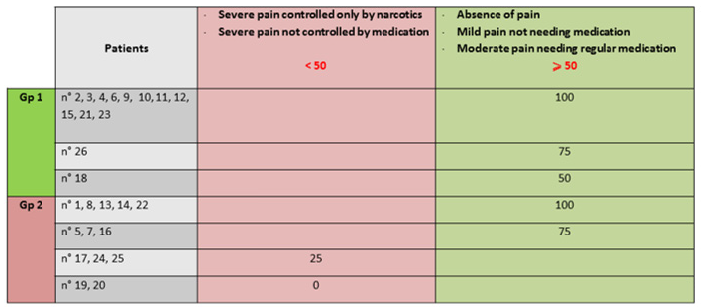
The item about appearance evaluated its changing because of a tracheostomy tube or cervical swelling and its repercussion on daily activities. No significant correlation was found between the change of appearance and the QoL (p= 0,48 >0,05) (Table 2).
Table 2:Answers of 2 groups of patients about appearance.
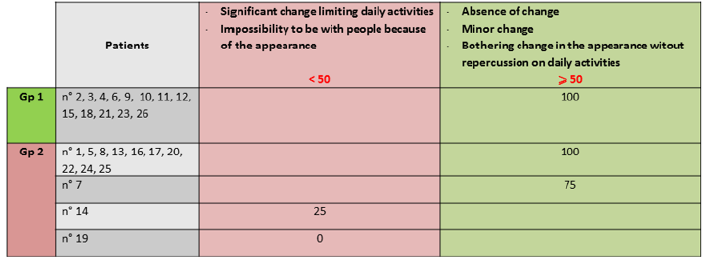
The repercussion of cancer on the daily activities was evaluated by a 5 possible responses question, from total preservation of activity to being stuck in bed or chair, not leaving home. No significant correlation was found between the limitation of activity and the QoL (p= 0,16 >0,05) (Table 3).
Table 3:Answers of 2 groups of patients about limitation of activity.
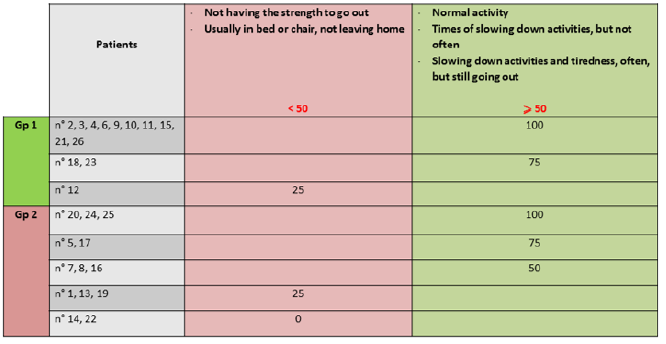
Recreation consisted on the possibility to get out and enjoy life, but it was not considered as a significant factor affecting negatively the QoL (p= 0,16 >0,05) (Table 4).
The swallowing disorder was described according to the consistency of food concerned with 4 possible answers. No significant correlation was found between the severity of dysphagia and the QoL (p= 0,48 >0,05) (Table 5).
Table 4:Answers of 2 groups of patients about recreation.
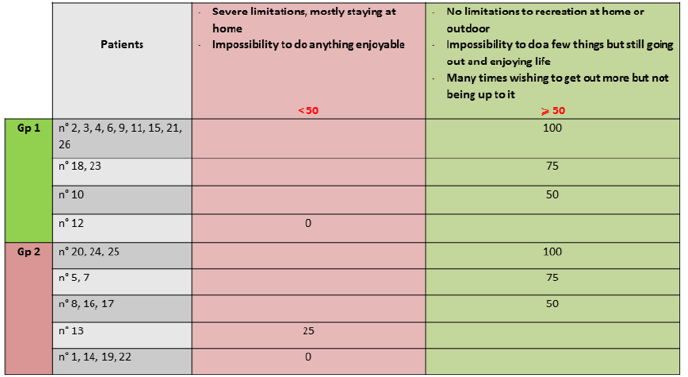
Table 5:Answers of 2 groups of patients about swallowing.

The chewing function was also described according to the consistency of food concerned with 3 possible answers. No significant correlation was found between the severity of chewing trouble and the QoL (p= 1 >0,05) (Table 6).
Laryngeal cancer may affect speech mainly by the dysphonia secondary to fixation or diminution of mobility of the vocal cords or because of the tracheostomy tube. However, no significant correlation was found between the severity of speech trouble and the QoL (p= 0,41 >0,05) (Table 7).
Table 6:Answers of 2 groups of patients about chewing.

Table 7:Answers of 2 groups of patients about speech.
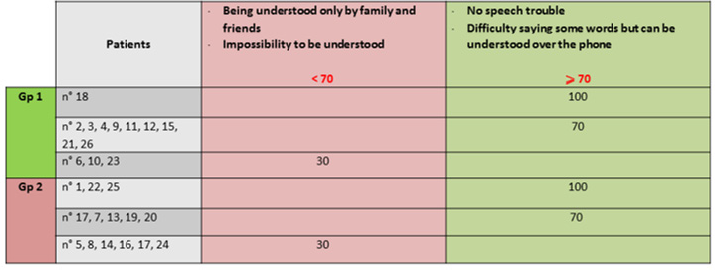
No significant correlation was found between shoulder pain and the QoL (p= 1 >0,05) (Table 8).
Taste and saliva disturbances did not seem to affect significantly the QoL of our patients with p= 1 (>0,05) for both items (Tables 9, 10).
Table 8:Answers of 2 groups of patients about shoulder pain.
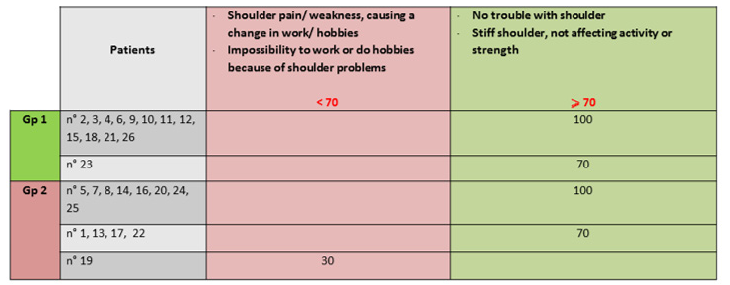
Table 9:Answers of 2 groups of patients about taste.

Table 10:Answers of 2 groups of patients about saliva.

The psychological level was evaluated based on how the cancer affects the patient mood, with 5 possible answers lowering from excellent mood to extreme depression. It appears that there is a significant correlation between the presence and intensity of depression and the QoL (p= 0,03 <0,05) (Table 11).
Table 11:Answers of 2 groups of patients about mood and depression.

The second psychological element evaluated was the anxiety about the cancer, but it seemed not significantly affecting the QoL (p= 0,16 >0,05) (Table 12)..
Finally, the 3 issues chosen as the most important during the past 7 days were pain, desperate mood and speech trouble.
Table 12:Answers of 2 groups of patients about anxiety.
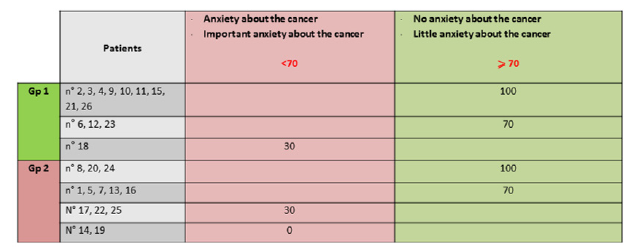
Discussion
Epidemiology
Laryngeal carcinoma is the third most common malignancy in the head and neck region with an estimated incidence in 2016 of 8/100,000 in males and 1.4/100,000 in women, males being 7 times more affected [1, 2]. In Casablanca, Morocco, laryngeal carcinoma represents 2% of all cancer locations recorded between 2008 and 2012, with a rate of 4,1% in males and less than 1% in women. Thus, men represented 92,3% of all the registered cases [3]. The peak age is between 55 and 65 years old [1]. Also, there are racial disparities making African Americans more likely to develop the cancer at a younger age with higher incidence and mortality compared with Caucasians [2]. Squamous cell carcinoma remains the most common histological type involving the mucosal surfaces of the larynx [4].
Within the last 20 years, the overall incidence is declining, more significantly in men. The synthesis of the findings from endoscopy, imaging and biopsy, next to a multidisciplinary approach are prerequisite for initiation of stage-appropriate treatment. Unfortunately, near 100% of patients present advanced (stage III or IV) disease at diagnosis affecting the mortality rate [1, 2].
Laryngeal cancer unique morbidities
The importance of the laryngeal functions makes unique morbidities in case of laryngeal carcinoma. Dysphonia, described as a loss of natural voice can be secondary to vocal cords paresis or immobility, or a tracheostomy that can be perceived by some patients as a disfigurement. In addition to the tumor airway obstruction, the loss of airway protection during swallowing and major impairments in daily activities can be observed with this disease and require special consideration [2, 5]. Each one of these parameters should be evaluated by a professional such as speech pathologists and dieticians in order to make appropriate recommendations regarding swallowing function and appropriate nutritional care during treatment [2].
Thereby, the treatment remains challenging since it needs to find a balance between oncological control and organ and functional preservation. Since total laryngectomy involves psychological and social aspects of losing the ability of voice, and impaired swallowing, there has been a move away from open surgery to multimodal techniques with the aim of organ preservation such as chemo- radio therapy with no final proof of improving overall survival [6]. But, conservative surgical approaches are successful when the appropriate patients are selected [2].
Health-related quality of life
“Health” was defined in 1948 by the World Health Organization (WHO) as “the state of complete physical, mental and social well-being and not merely the absence of disease or infirmity”. They also described QOL as an “individual’s perception of his or her position in life in the context of the culture and value systems in which the patient lives and in relation to his or her goals, expectations, standards, and concerns”. The form “health-related quality of life” (HRQoL) narrows QoL to aspects relevant to health. It is a multidimensional concept reporting the physical, role functioning, social, and psychological aspects of well-being and functioning, with an objective evaluation on what the person can do, and a subjective assessment including its own perception and appraisal of the measurement of health status [7].
Patients with laryngeal cancer usually experience important morbidities and disturbances in their vital functions such as breathing and swallowing, secondary to the disease and to its treatment, resulting in a negative impact on their QoL during all the process of care. Studies resumed the main conditions affecting QoL in patients with head and neck cancer, in a more global point of view, in the demographic features such as age, gender, educational level and marital status, the stage of the disease, the presence of comorbidities, the presence of tracheotomy or feeding tube, and concerning the treatment modalities, chemo-radiotherapy and neck dissection [8]. Also, many prospective studies did not find any significant differences between younger and older patients or at least, a better self-reported global QoL in older patients [4].
Questionnaires and scores
Knowing the factors affecting negatively the QoL may open adjuvant ways of adapted treatments answering the patients’ needs and concerns [8]. A variety of instruments are available to assess Health-related QoL: Generic measures can be used, non-specific to cancer patients, such as the Short Form Health Surveys (SF-36, SF-12); Generic cancer measures, such as the EORTC quality of life core questionnaire (QLQ-C30); Head and neck cancer-specific instruments including the University of Washington Quality of Life Questionnaire (UW-QOL) which is the one used in our study; and the Functional Assessment of Cancer Therapy Head and Neck [4].
The UW-QOL was chosen since it is simple, yet clinically relevant, suitable for routine clinical practice. It has been developed following multiple versions until becoming multi-factorial, specific and including both physical and emotional domains, which made it used in substantial number of published studies facilitating its rigorous validation. The current version 4 of the UW-QOL used here, is a questionnaire which consists of 12 single question domains, these having between 3 and 6 response options that are scaled evenly from 0 (worst) to 100 (best) according to the hierarchy of response. The domains are pain, appearance, activity, recreation, swallowing, chewing, speech, shoulder, taste, saliva, mood and anxiety. Patients are also asked to choose up the three issues that have been the most important to them. And finally, there are three global questions, one about how patients feel relative to before they developed their cancer, one about their health-related QOL and one about their overall QOL [9]./
“Pain” in laryngeal cancer
As in our results, it comes out from multiple studies that pain is experienced as one of the most impactful sources of distress in patients with laryngeal cancer and has been linked to poorer outcomes and decreased QoL [4, 10].
The physiopathology is related to the fact that cancer and immune cells in the area of tumour release neuroimmune mediators that interact with a variety of receptors. In another hand, the neuropathic condition can be related to the tumour growing in the surroundings of peripheral nerves compromising their integrity. Both of these actions on peripheral nerves can result in central sensitization [10]
It is an important parameter to consider, since pain values often increase with treatment and stay on high levels in the period following surgery, radiotherapy or chemotherapy, until 6 months or more. Additionally, these patients with pain are more likely to struggle with depression and anxiety [4, 10]. So, if pain is not properly addressed, even if the number of laryngeal cancer survivors increases, their QoL would still be affected significantly. Thus, screening programmes and questionnaires assessing cancer pain can be effective for targeting pain as a first step, followed by treatment protocols [10].
Next to opioid medications, which utilization is likely to increase with the increased patient pain with unwarranted fear of addiction, the recent strategy in the clinical management of pain is to focus on prevention. Several newer antiepileptic drugs (AEDs), such as Gabapentin and Pregabalin, have been found to decrease the perception of pain in patients with head and neck cancer, with mild and well-tolerated side-effect profile. By inhibiting the actions of the A₂ subunit protein, the glutamate release, the activity of NMDA receptors and voltage-gated sodium channels, next to enhancing the activity of voltage-gated potassium channels, these medications have a potential role in prevention and decreasing cancer pain [11].
“Depression” in laryngeal cancer
Depression, with a prevalence dramatically higher in cancer patients than in general populations, is considered, next to anxiety, panic and social isolation, among the problems that can significantly impact the patient’s life, and is included in the definition of the psychosocial distress in the context of cancer which is defined by the NCCN as “a multifactorial, unpleasant, emotional experience of a psychological, social, and/or spiritual nature that may interfere with the ability to cope effectively with cancer, its physical symptoms, and its treatment”. Indeed, it has been linked to higher mortality rates and poorer treatment tolerance. However, these psychological issues frequently remain unidentified or unassessed [4, 5].
Specifically, patients with head and neck cancer were reported to have the highest levels of depression, up to 57%, which was almost four-times higher compared to patients with other cancer types such as breast cancer and skin cancer whom prevalence rate was about 12,5% [5]. Also, studies evaluated the psychological and emotional status of patients with laryngeal cancer showing its extensive nature. Depressive symptoms which may start with the diagnosis reach a peak at the end of treatment [12].
Thus, effective and adequate care should be dedicated to this psychological issue. Antidepressant medication demonstrated positive effects on depression scores, better with higher initial depression scores. The prescription concerned mainly Selective Serotonin Reuptake Inhibitors and Noradrenergic and Specific Serotonergic antidepressant medication, within the recommended therapeutic dose ranges [13]. In patients with advanced cancers, an evaluation of depression based on the Edinburgh depression scale (EDS) and Patient Health Questionnaire 9 (PHQ9) showed that antidepressant medication had little impact on the scores [5]. Also, medication is often employed along with behavioral therapy and psychosocial interventions [12, 13].
In fact, psychological intervention seemed to have a positive effect on the reduction of depression and improvement of QoL of patients with laryngeal cancer. Mediated by pre- trained and professional psycho-oncologists, the purpose was to educated patients to fully understand the psychological problems they may confront during the treatment process, the improvement and coping strategies, in addition to reduce their sense of shame leading them to accept that psychological problems are normal physiological re sponses to external pressure and be aware of the social resources and professional support they will obtain following their needs. The program consisted on multiple lessons for small groups, based on PowerPoint presentations, group discussions, worksheets, and guided scenario simulations. Last by not least, duration and expenses of hospitalization were also significantly less [5].
Conclusion
Laryngeal cancer represents a physical and psychological trauma, altering significantly the patients QoL mainly because of the pain it generates and the heavy emotional burden it causes. Thus, next to surgery and radio-chemotherapy, the medical care should focus on understanding the association of cancer pain and depression in order to make multimodal strategies to cure patients effectively and preserve their QoL.
Acknowledgement
None.
Conflict of Interest
No conflict of interest.
References
- Chatenoud L, Garavello W, Pagan E, Bertuccio P, Gallus S, et al. (2016) Laryngeal cancer mortality trends in European countries. Int J Cancer 138: 833-842. Bozzato A, Pillong L, Schick B, Lell MM (2020) [Current diagnostic imaging and treatment planning for laryngeal cancer]. Radiologe 100(11): 1026-1037.
- Steuer CE, El-Deiry M, Parks JR, Higgins KA, Saba NF (2017) An update on larynx cancer. CA Cancer J Clin 67(1): 31-50.
- CANCER REGISTER of the Greater Casablanca Region for the period 2008-2012, 2016 (Edn.).
- McDowell L, Rischin D, Gough K and Henson C (2022) Health-Related Quality of Life, Psychosocial Distress and Unmet Needs in Older Patients With Head and Neck Cancer. Front Oncol 12: 834068.
- Zhang S, Chen H, Zhang M, Sun X, Liu X (2020) Reduction of depression symptoms in laryngeal cancer patients receiving psychology services. Am J Transl Res 12(10): 6637-6645.
- Mirza O, Loughran S (2018) New Developments in the Management of Laryngeal Cancer. Int J Head Neck Surg 9(2): 54-100.
- de Wit M, Hajos T (2013) Health-Related Quality of Life. In: Gellman MD, Turner JR (Eds.), Encyclopedia of Behavioral Medicine. Springer, New York, NY.
- Tahir E, Sözen T (2017) Quality of Life and its Assessment Methods in Laryngeal Cancer. J Otolaryngol ENT Res 8(4): 00255.
- (2012) University of Washington Quality of Life Questionnaire (UW-QOL v4) Guidance for scoring and presentation Derek Lowe & Simon N Rogers.
- Schmidt BL, Hamamoto DT, Simone DA, Wilcox GL (2010) Mechanism of cancer pain. Mol Interv 10(3): 164-178.
- McMenamin EM, Grant M (2015) Pain Prevention Using Head and Neck Cancer as a Model. J Adv Pract Oncol 6(1): 44-49.
- Jiang H, Wang BQ, Gao ZH, Song KY (2018) [Research progress on the changes of emotional and cognitive functions in patients with laryngeal cancer]. Lin Chung Er Bi Yan Hou Tou Jing Wai Ke Za Zhi 32(11): 880-882.
- Lloyd-Williams M, Payne S, Reeve J, Kolamunnage Dona R (2013) Antidepressant medication in patients with advanced cancer--an observational study. QJM 106(11): 995-1001.
-
K El Bouhmadi*, Y Oukessou, I Larhrabli, S Rouadi, R Abada, M Roubal, M Mahtar. Health-Related Quality of Life in Patients with Laryngeal Cancer: Evaluation of the Affecting Factors. On J Otolaryngol & Rhinol. 5(5): 2022. OJOR.MS.ID.000624.
-
Laryngeal cancer, Head and neck surgery, Speech trouble, Larynx, Tracheostomy, Loss of natural voice, Vocal cords, Speech pathologists, Neck dissection, Taste.
-

This work is licensed under a Creative Commons Attribution-NonCommercial 4.0 International License.






